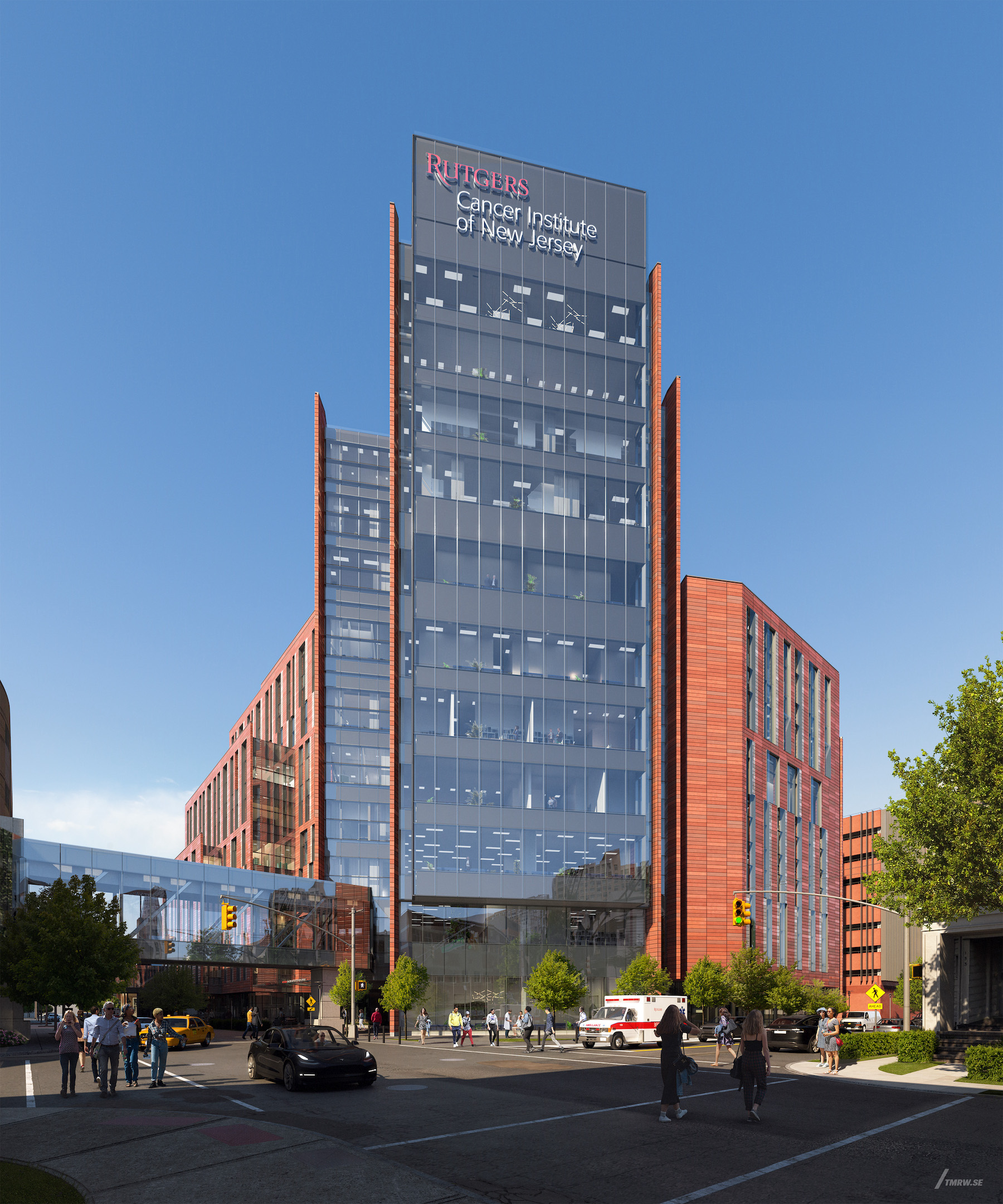Early next year, the New Brunswick (N.J.) Development Corporation, in collaboration with RWJBarnabas Health and the Rutgers Cancer Institute, is scheduled to open the Jack & Sheryl Morris Cancer Center, which will be the Garden State’s first National Cancer Institute-designated Comprehensive Cancer Center.
This 12-story, 520,000-sf, $750 million project, which broke ground in June 2021 and topped off in November 2022, will be a freestanding building that combines in- and outpatient services with research. A skywalk will connect the Cancer Center to the existing Rutgers Cancer Institute of New Jersey and the Robert Wood Johnson University Hospital.
The new building will include 96 inpatient beds on three floors, with one entire floor for surgical services. There will also be 84 infusion bays, 74 exam rooms, and state-of-the-art imaging and diagnostic equipment that includes four linear accelerators. The Cancer Center will offer in- and outpatient radiation oncology services.
More than 100 scientists will have access to 10 research labs within the Cancer Center.
The Cancer Center will be integrated into RWJBarnabas’ “Navigator” program, which allows patients to take a more active part in managing their treatment and longer-term healthcare.
The Building Team for the Cancer Center includes HOK (architect and designer), a joint venture between Jingoli Construction and LF Driscoll (GC), and O’Donnell & Naccarato (SE). As part of this project, RWJBarnabas picked up the $55 million tab to build Blanquita B. Valenti Community School, a three-story elementary school for 800 students that opened last September. Jack Morris, the Cancer Center’s benefactor and namesake, is the founding chairman of RWJBarnabas Health, and with his wife leads Edgewood Properties, a property development and management firm.
An innovation hub in the city’s core

The Morris Cancer Center isn’t the only project that’s positioned to reshape New Brunswick’s reputation, urban landscape, and economy, at a time when this city of 56,400 is only growing marginally and has struggled to maintain its jobs base. After years of languishing as a massive excavation hole, The Health and Life Science Exchange (HELIX NJ), a four-acre innovation district which was co-developed by SJP Properties and the New Brunswick Development Corporation, finally began construction last July and is scheduled to start opening next year.
HELIX’s $650 million first phase, a 13-story 573,400-sf building, will house an Innovation HUB, Rutgers Robert Wood Johnson Medical School (on four floors), and a research facility, as well as retail space, a 10,000-sf market hall, and a 3,000-sf restaurant that opens onto a 70-ft-wide plaza.
Rutgers University, which will occupy three-quarters of HELIX’s first building, has committed $270 million to recruit and retain 80 translational research investigators to work in HELIX.
HELIX’s $731 million second phase, designed by HDR, will include 600,000 sf of built-to-suit office and lab space. (Last month, Nokia announced plans to move Nokia Bell Labs into HELIX.) Phase 3 will be a mixed-use 42-story building with 220 housing units. Jingoli Construction is HELIX’s general contractor.
HELIX was the first program approved under the New Jersey Economic Development Authority's Aspire tax credit program, which was created by legislation passed in 2020.
Related Stories
Great Solutions | Aug 23, 2016
GBBN designers take on wellness research
In a new research paper, three healthcare specialists present factors that contribute to a psychological state that is receptive to healing.
Great Solutions | Aug 23, 2016
Reusable infection control barriers ease hospital renovation
Clark Construction Group pilots the Edge Guard system on the Fair Oaks (Va.) Hospital reconstruction project.
Great Solutions | Aug 23, 2016
Mobile emergency room arrives just in time for Alabama hospital
The MED-1 Mobile Hospital Unit serves as a lower-cost solution during construction of new ED.
Great Solutions | Aug 23, 2016
Virtual care facility serves remote patients, may reduce readmissions
Mercy’s new high-tech medical center equips its medical professionals to deliver care at the bedside of patients anywhere.
Great Solutions | Aug 23, 2016
11 great solutions for the commercial construction market
A roll-up emergency department, next-gen telemedicine center, and biophilic cooling pods are among the AEC industry’s clever ideas and novel innovations for 2016.
Healthcare Facilities | Aug 16, 2016
The future of healthcare design education: 5 takeaways from ACHA 2016
Creating a network of experts to talk next generation healthcare design education
Healthcare Facilities | Aug 15, 2016
Future proofing hospitals
By improving the physical layout of hospitals and medical facilities, we can enhance and increase safety mechanisms, improve care, and help reduce the exposure to medical errors, writes Skanska USA's Andrew Quirk.
Healthcare Facilities | Aug 10, 2016
11 principles for pediatric healthcare design
Engagement at all levels, designing with families in mind, and integrating flexible spaces are all important design considerations to keep in mind for pediatric healthcare planning, writes HDR's Brian Zabloudil.
Healthcare Facilities | Aug 9, 2016
Key strategies to reduce healthcare facility costs and maintain operations
The right approach during the planning, design, and construction of a new facility can yield a positive return on investment and lower the overall cost basis for ongoing operations, writes Steve Higgs, Senior Managing Director with CBRE Healthcare.
| Aug 8, 2016
HEALTHCARE GIANTS: Age-simulation technology aids design for the mobility impaired
As the 65+ population continues to rise, the AEC industry needs to better understand the stresses and anxieties those who are mobility impaired face when navigating spaces like medical facilities.

















